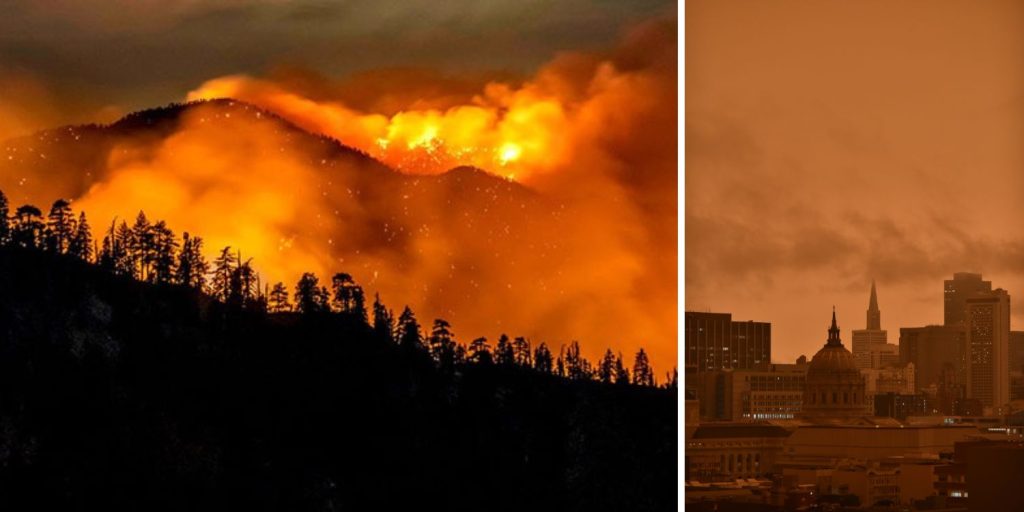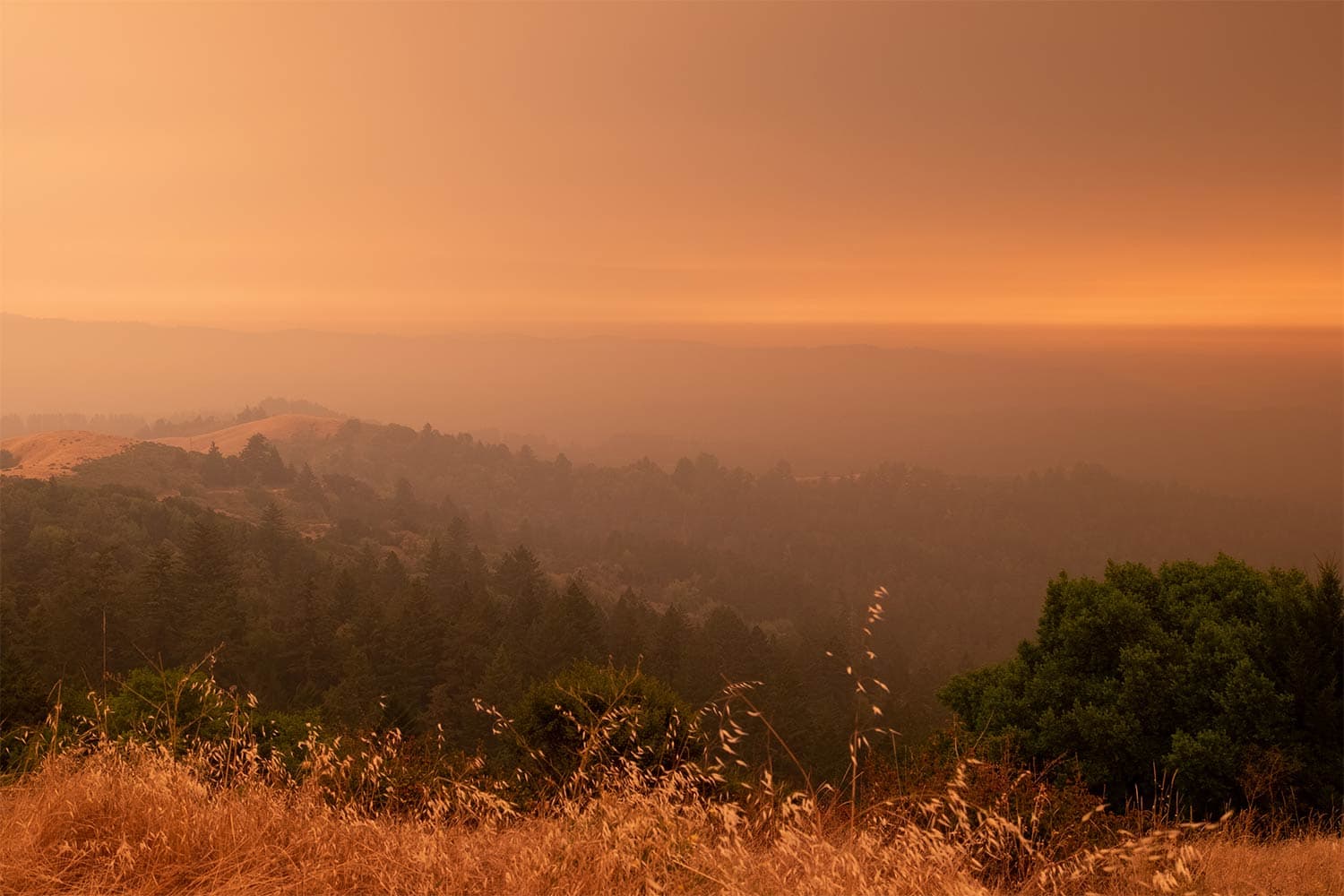When Wildfire Smoke Clears, Its Impacts Remain
A Sacramento resident reflects on the long-term impacts of living in a cloud of smoke.
Wildfire smoke obscured California’s Santa Cruz mountains in September 2020
In satellite imagery, California looked as though it had been cut open. The small fires were puncture wounds; the larger ones, deep gashes. From each, a dense plume spilled across the landscape, like something leaking from the earth. In my Sacramento backyard, it was impossible to tell where the smoke was coming from or where it was going: the whole thing faded into a sunless, washed-out grey. On the worst days, visible flecks of ash filtered through the air, settling on rooftops and windshields.
Autumn usually marks the beginning of wildfire season in California. This year it came earlier and bigger. In mid-August, a lightning storm sparked hundreds of fires in dozens of counties. Over the ensuing weeks, they merged into several record-breaking megafires.
From late August to mid-September, the smoke was constant. Panic quickly faded, replaced by a low, constant hum of dread. Orange skies, red moon, raw throat, Excedrin. Patch the gaps in the windowsill with painter’s tape. Refresh AirNow.gov again. Watch the air purifier’s LED flip from purple (bad) to red (worse). Remind my mom in Oakland to make sure her air filter is HEPA-certified. Search Zillow for condos in Minneapolis.
Like most Californians, my home has not been threatened by flames. But if every fire is a natural disaster, each releases into the atmosphere another, more subtle disaster, one that diffuses, settles and lingers.
Orange skies, red moon, raw throat, Excedrin. Watch the air purifier’s LED flip from purple (bad) to red (worse).
Clean air is a gaseous soup composed primarily of oxygen, nitrogen, carbon dioxide, and water vapor. Wildfire adds to this mixture such unsavory ingredients as carbon monoxide, ozone, and microscopic flotsam termed “particulate matter,” all of which can make it harder to breathe. Measurements of these and other pollutants are used to calculate the Air Quality Index (AQI), a rating of 0 to 500. An AQI above 100 indicates possible health effects for sensitive groups; at 150, air is considered unhealthy for the general public.
On September 8, Sacramento recorded an AQI of 484. In some places, air pollution was so intense that measurements exceeded the usual top end of the index, clocking in above 700. Such was the poisoned soup that poured into millions of nostrils, down bronchial tubes, in and around alveoli.
There aren’t many studies exploring the health effects of repeated, severe wildfire smoke exposure. Partially because, until recently, not many people had experienced repeated, severe wildfire smoke exposure. It is clear that wildfire smoke, like other kinds of air pollution, exacerbates asthma and other respiratory diseases. Researchers from the University of Montana found that air pollution from the 2017 wildfire season more than doubled the state’s influenza cases the following winter. The authors suggest that — as has been shown in mice — smoke exposure impairs the immune system’s ability to fight infection. They and other researchers anticipate that people exposed to smoke may also be more easily infected with Covid-19, and more likely to die from it.
Researchers anticipate people exposed to smoke may be more easily infected with Covid-19, and more likely to die from it.
Other studies have linked smoke exposure to a variety of health effects, including premature birth, heart attacks, and overall rates of death. But according to Dr. Colleen Reid, a University of Colorado environmental epidemiologist, most of the research has only examined the effects of a single period of smoke exposure. “I think we’re missing the fact that there are these repeated wildfires over time,” she said.
Since the onset of the fire season, Reid has received near-constant inquiries from media outlets and concerned citizens about how to stay safe. The compounding health demands of the pandemic (stay isolated), heat waves (stay cool) and smoke (stay inside) have made it hard to give advice people want to hear.
I, like many other Californians, spent weeks sandwiched between my window air-conditioning unit and air purifier. But that’s not feasible for thousands of unhoused people, hundreds of thousands of agricultural workers, and millions of families who simply cannot afford a $200 air purifier. Even for those who can, “telling people to shelter in place for long periods of time has mental health implications,” said Reid. She has experienced those implications firsthand, as smoke from Colorado fires kept her family in Boulder indoors for days on end.
“When you have a few days in a row where you can’t get outside and exercise because the air pollution is so bad — or when you have a few days in a row where I’m telling my children that we’re going to just stay inside and play — it’s hard,” she said. “If that becomes normal, that becomes really hard to think about.”

L: The Bobcat Fire raged in and around the Angeles National Forest northeast of LA for close to two months, burning over 45,000 hectares. R: The sky over San Francisco turned an eery shade of orange as a result of wildfire smoke.
And there is every indication that yearly megafires and smoke warnings will become normal. As University of Illinois atmospheric scientist Dr. Cristi Proistosescu wrote in probably the pithiest and most unsettling climate tweet of September: “Don’t think of it as the warmest month of August in California in the last century. Think of it as one of the coolest months of August in California in the next century.” At a recent conference, Reid says a speaker paraphrased the tweet thus: “Don’t think of 2020 as the worst fire season yet, but as the best of what’s to come.”
While that may be true in spirit, fire ecologist Dr. Allie Weill told me, it probably isn’t literally accurate. The lightning storm that ignited record-setting fires in August is still considered a rare event, one that made 2020 unusually destructive. “Every year is different, and that’s going to continue to be true,” Weill said. But in general, California fires are becoming larger and more destructive. Explaining why isn’t easy. There are “a lot of different reasons that combine into an almost a perfect storm,” she said.
First is what she calls “the story everyone knows”: fire suppression. For thousands of years, Indigenous peoples have used small, controlled burns to promote the growth of important plants and limit the amount of dried brush that could fuel larger fires. But starting in the early 20th century, US forest managers forbade the practice and attempted to completely eradicate wildfire from the western states. More recently, ecologists have come to see fire as an integral part of California’s landscape, even partnering with tribes to bring intentional burns back to the forest. But fire suppression has left forests in the Sierra Nevada dense and fuel-laden, making wildfires larger and more destructive.
Don’t think of 2020 as the worst fire season yet, but as the best of what’s to come.
The 2013 Rim Fire — at the time the third-largest fire in the state’s history — was touted by some ecologists as a consequence of decades of forest mismanagement. Two years after the fire, I picked up a summer job mapping the trees left in its wake. Though it had burned over 100,000 hectares of Sierra Nevada forest, it hadn’t done so evenly: some stands were transformed into meadows dotted with charcoal obelisks, while others seemed nearly untouched.
It was in one of these more intact pieces of forest, kilometers into the backcountry and hours away from cell service, that I smelled smoke. Under the canopy, there was no telling how far it had travelled. But the scar of the Rim Fire, my boss assured me, was the safest place to be. The new flames, even if they were close, would flow toward more overgrown forest, away from us. She was right, although I never got used to the smell of burning pines.
The complex history of fuel buildup and fire suppression is presumably what President Trump was trying to invoke with his 2018 remarks about the virtues of forest-raking. But that history does not apply to all of California. Some of the state’s deadliest fires occur not in any kind of forest, but in the shrubby chaparral of Southern California and the grasslands of wine country.
In these environments, Weill says an oft-neglected factor is the continued intrusion of humans into lands that were formerly wild. In the past 30 years, California’s population has grown by nearly 10 million people. While cities have become denser, development has also sprawled into sparsely populated foothills and valleys. More development means more power lines, more cigarettes, more gender reveal explosions. In many of these areas, dry grass and shrubs can fuel even a stray spark into a megafire.
Weill, like me, lives in Sacramento, an urban center surrounded by miles of irrigated farmland. Exposed as we are to smoke, we’re pretty sheltered from actual flames. “It feels like a fire is very close when there’s smoke,” she admitted. “Especially when there’s ash dropping from the sky.” But in September, when she learned that some of her nearby friends had bags packed, she reassured them their chances of being evacuated were slim. “I don’t know where you would go that’s safer,” she said.
She may have meant that as a comfort, but I paraphrase it in my head — there’s nowhere safer for you to go — and it’s chilling.
It’s also somewhat true. Friends of mine, after fleeing north in September, were quickly chased out by Oregon’s own record-setting fires. Throughout their road trip through Montana and Idaho, smoke followed.
Although changes to fire patterns have been most obvious in California, they’re occurring all across western North America. As climate change creates hotter, drier conditions, fires in all ecosystems are growing larger and more destructive. Even if ideal forest management practices reduced fuel levels in forests, even if centralized development stemmed urban sprawl into wildlands, climate change would still cause more extreme fires. Things would still be on track to get worse as global temperatures continue to rise.
What we’re living right now is the future I was told about 20 years ago. I thought it was maybe 50 years out, but really it’s already happening.
Colorado’s Reid, who has studied fire for decades, knew climate change would produce massive megafires. She didn’t anticipate that it would happen so soon.
“I feel like what we’re living right now is the future I was told about 20 years ago. I thought it was maybe 50 years out, but really it’s already happening,” she said. “To think it’s on track to continue to get worse is really depressing.”
When I ask ecologist Weill if she plans to stay in California, she registers somewhere between resigned and sanguine. “We have our fires, but other places are having floods and hurricanes and whatever else,” she said. “There are few places that aren’t going to have issues.”
I too have no immediate plans to relocate. Periodic fantasies of moving to the Upper Peninsula of Michigan aside, my life is firmly rooted in California. I’m not sure how much more smoke will fill the sky before I reconsider.
This article was originally published under the title “Can the Smoke Truly Clear in California?”
